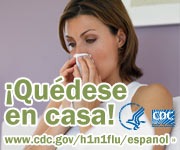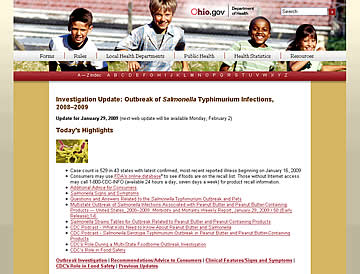The Centers for Disease Control and Prevention (CDC) and the U.S. Department of Health and Human Services (HHS) are working together to provide consumers and partners with social media tools that access information about the ongoing 2009 H1N1 Flu outbreak. Visit the CDC.gov 2009 H1N1 Flu and PandemicFlu.gov Web sites for information on 2009 H1N1 Flu.
2009 H1N1 Flu Social Media Tools
To encourage information sharing, collaboration, and interactivity, CDC provides social media tools. Widgets, mobile information, online videos and the like reinforce and personalize messages, reach new audiences, and build a communication infrastructure based on open information exchange.
Sign up for email updates to receive announcements of new products we add to this page.
Widgets
A widget is a CDC.gov application that displays the featured content directly on your web page. You can embed content in personalized home pages, blogs, and other sites. Once you've added the widget, there's no technical maintenance. CDC.gov will update the content automatically.
Adding a CDC.gov widget to your page means that you will have up-to-date, credible health and safety content in your favorite spaces – no more searching or browsing. Stay informed about the health content that is most meaningful to you—all of our widgets are available at http://www.cdc.gov/widgets/.
HHS 2009 H1N1 Flu Widget
Add a widget to your Web site or blog and share information about 2009 H1N1 Flu in English or Spanish. By adding one of these widgets, you will be part of the national effort to keep consumers informed about 2009 H1N1 Flu. You can find the code for these widgets on the Department of Health and Human Services Widget page.
CDC 2009 H1N1 Flu Widget
Help spread the word about H1N1 Flu and how to prevent it. Add a widget to your Web site, portal home page or on your blog. Let your Web site visitors know how to stop the spread of H1N1 Flu and where to get more information about H1N1 Flu. You can find, download and share this widget at http://www.cdc.gov/widgets/.
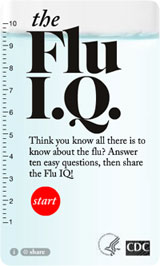 Flu I.Q. Widget
Flu I.Q. Widget
The Flu I.Q. widget is an interactive quiz to test your flu knowledge. Place the Flu I.Q. Widget on your Web site, portal home page or on your blog to help others raise their flu I.Q. too! Don’t worry if you don’t know all the answers at first; the Flu I.Q. widget is an easy and fun way to learn what's true about flu. You can find, download and share this widget at http://www.cdc.gov/widgets/.
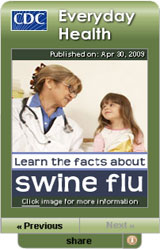 Everyday Health Widget
Everyday Health Widget
Place the Everyday Health Widget on your Web site, portal home page, or in your blog to give you and your visitors a current healthy living tip year round. The widget is available in English or Spanish. You can find, download and share this widget at http://www.cdc.gov/widgets/. The Spanish version of the widget, Salud al Día is available at http://www.cdc.gov/spanish/Widgets/.
Mobile Information

Access important information about 2009 H1N1 Flu via the mobile CDC Web site. Get information, resources and updates from anywhere by pointing your mobile browser to http://m.cdc.gov/.
Buttons
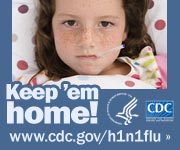 Add a button to your Web site. Let your Web site visitors know how to stop the spread of 2009 H1N1 Flu and where to get more information about 2009 H1N1 Flu.
Add a button to your Web site. Let your Web site visitors know how to stop the spread of 2009 H1N1 Flu and where to get more information about 2009 H1N1 Flu.
Choose a 2009 H1N1 Flu Button in English
Online Videos
Watch these videos to learn more about the 2009 H1N1 Flu and things you can do to prevent becoming sick. By visiting CDC’s online video sites, you can also learn how to embed these videos in your Web pages for others to watch.

2009 H1N1 Flu
General Instructions for Disposable Respirators: this podcast, intended for the general public, demonstrates how to put on and take off disposable respirators for use in areas affected by the influenza outbreak.
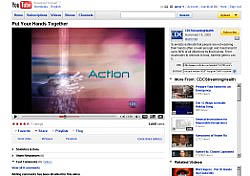
Put Your Hands Together
Scientists estimate that people are not washing their hands often or well enough and may transmit up to 80% of all infections by their hands. From doorknobs to animals to food, harmful germs can live on almost everything. Hand washing may be your single most important act to help stop the spread of infection and stay healthy. You can view this video on the CDC YouTube Channel and embed it on your own blog or personal Web site.
Podcasts
Listen to CDC podcasts on 2009 H1N1 Flu and how handwashing can help stop the spread of infection and help you stay healthy. Podcasts can be accessed directly from the CDC Web site, or you can download audio and/or video podcasts to your desktop and portable music/video player for health information at your convenience and on the go.
eCards


Keep your friends, family and coworkers informed. Send them tips for staying healthy and avoiding the flu by washing their hands. Visit the CDC Health-e-Cards site today to send a loved one an eCard.
RSS Feeds
Subscribe to RSS updates for ongoing news related to the 2009 H1N1 Flu outbreak. News and alerts will be delivered directly to your RSS reader when you sign-up for the CDC 2009 H1N1 Flu Update feed.
Twitter/Microblogs Updates

Follow updates from CDC on Twitter:
CDC's new Twitter feed for Emergency Information
Emergency and preparedness information from CDC and partner agencies.
CDC’s Twitter feed for Interactive Media News
For Health Professionals interested in staying up-to-date with CDC's interactive media activities (includes alerts when new mobile content and widgets are released by CDC)
CDC's Twitter Feed for Flu Updates
Updated information related to about 2009 H1N1 Flu, seasonal flu, and related influenza information.
PandemicFlu.gov Twitter Feed
Updated information related to about pandemic flu and related influenza information.
Image Sharing

View and share 2009 H1N1 Flu images from the CDC Flickr site or the CDC Public Health Image Library.
Social Networking Sites
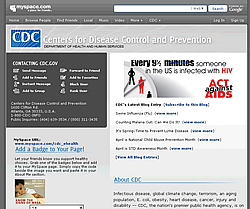
Stay informed about the 2009 H1N1 Flu outbreak through CDC's social network profiles:
More Information
Web Sites
Find updated information from CDC.gov:
- General Information about 2009 H1N1 Flu
Q & A's, including guidance for treatment and infection control, background information, and audio and video resources - 2009 H1N1 Flu and You
What is 2009 H1N1 Flu? - Key Facts about 2009 H1N1 Flu
How does 2009 H1N1 Flu spread? - Human 2009 H1N1 Flu Investigation
Information about the investigation of human 2009 H1N1 Flu in the U.S. - PandemicFlu.gov
CDC National Contact Center
Representatives are available 24/7 to answer your questions in English and Spanish. For up-to-date information about 2009 H1N1 Flu and hundreds of other health and safety topics:
- Call: 1-800-CDC-INFO (1-800-232-4636), TTY: (888) 232-6348, English/Spanish, 24 Hours/Every Day
- Email: cdcinfo@cdc.gov
- Postal Mail:
Centers for Disease Control and Prevention
1600 Clifton Rd,
Atlanta, GA 30333
U.S.A.
On this page



The U.S. Department of Health and Human Services (HHS), Food and Drug Administration (FDA), and Centers for Disease Control and Prevention (CDC) are working together to provide consumers and partners with social media tools to access information about the ongoing peanut butter and peanut-containing product recalls. This page will be updated as new communication approaches are employed.
Resources for Consumers
Online Product Recall Database
Search for Product Recalls (FDA)
FDA developed a recall database that enables consumers to search for products by brand name, product description, and more.
Blogs
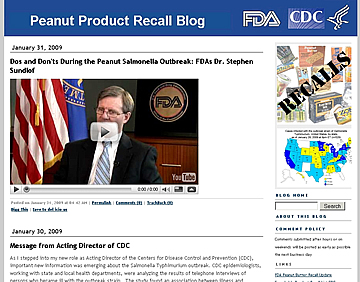 Learn more about the peanut butter and peanut-containing product recalls through blogs. The following blogs provide information about the product recalls and outbreak investigations,
and each encourages comments and conversations related to the blog posts.
Learn more about the peanut butter and peanut-containing product recalls through blogs. The following blogs provide information about the product recalls and outbreak investigations,
and each encourages comments and conversations related to the blog posts.
- HHS Peanut Product Recall Blog
(HHS)
This new blog will include posts from CDC, FDA and HHS representative. - CDC
National Center for Zoonotic, Vector Borne, and Enteric
Diseases (NCZVED) (CDC)
On the Public Health Matters Blog: Ingredient Driven Outbreaks: The Inside is Bigger than the Outside - Webinar for Bloggers
The webinar held on February 3rd, 2009, gave blog writers the chance to speak with FDA and CDC subject matter experts about the Salmonella Typhimurium outbreak efforts and future resources for bloggers during food safety incidents.- For more information about this event or to participate, please email NCHMInteractiveMedia@cdc.gov.
- More about CDC blog efforts
eMail Subscriptions
Sign up for email updates when Web site information on certain health topics from HHS, FDA and CDC is changed.
- FDA Email Updates (FDA)
- CDC Email Updates (CDC)
- HHS Email
Updates (HHS)
Health-e-Cards
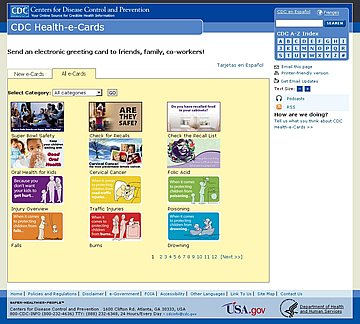 Keep your friends, family and coworkers informed. Send
them tips for staying healthy:
Keep your friends, family and coworkers informed. Send
them tips for staying healthy:
- CDC
Health-e-Cards (CDC)
Send cards to friends and family about peanut butter and peanut-containing product recalls, the Super Bowl, and much more.
Mobile Information
 Access
important CDC and FDA information about peanut butter
and peanut-containing product recalls via the new mobile
CDC Web site:
Access
important CDC and FDA information about peanut butter
and peanut-containing product recalls via the new mobile
CDC Web site:
- Point your mobile browser to http://m.cdc.gov (CDC)
Online Video
Watch a video from the FDA on things you should know during the peanut butter and peanut-containing product recalls. Watch the video on any of the following Web sites:
Phone/Email: CDC National Contact Center
Have questions about the peanut butter and peanut-containing product recalls? Representatives are available 24/7 to answer your questions in English and Spanish. For up-to-date information about the recalls and hundreds of other health and safety topics:
- Call 1-800-CDC-INFO (1-800-232-4636), TTY: (888) 232-6348, English/Spanish, 24 Hours/Every Day
- Email: cdcinfo@cdc.gov
- Postal Mail:
Centers for Disease Control and Prevention
1600 Clifton Rd, Atlanta
GA 30333, U.S.A.
Podcasts
Listen to podcasts with current information about the peanut butter and peanut-containing product recall and the Salmonella Typhimurium outbreak. You can watch any of these podcasts from your computer or download them to an MP3 player or mobile device.
![]() (English) Salmonella Serotype Typhimurium Outbreak in Peanut Butter and Peanut Butter-Containing Products
(CDC)
(English) Salmonella Serotype Typhimurium Outbreak in Peanut Butter and Peanut Butter-Containing Products
(CDC)
![]() Listen To This Podcast... (3:41) This podcast discusses the Salmonella Typhimurium outbreak in peanut butter and peanut butter-containing products. (Created: 1/21/2009 by National Center for Zoonotic, Vector-borne, and Enteric Diseases (NCZVED))
Listen To This Podcast... (3:41) This podcast discusses the Salmonella Typhimurium outbreak in peanut butter and peanut butter-containing products. (Created: 1/21/2009 by National Center for Zoonotic, Vector-borne, and Enteric Diseases (NCZVED))
Date Released: 1/21/2009
![]() (Spanish) Brotes infecciosos causados por Salmonella typhimurium en la mantequilla de maní y otros productos que la contienen
(CDC)
(Spanish) Brotes infecciosos causados por Salmonella typhimurium en la mantequilla de maní y otros productos que la contienen
(CDC)
![]() Listen To This Podcast... (3:48) Este podcast habla sobre los brotes infecciosos causados por Salmonella typhimurium en la mantequilla de maní y otros productos que la contienen. (Created: 1/21/2009 by National Center for Zoonotic, Vector-borne, and Enteric Diseases (NCZVED))
Listen To This Podcast... (3:48) Este podcast habla sobre los brotes infecciosos causados por Salmonella typhimurium en la mantequilla de maní y otros productos que la contienen. (Created: 1/21/2009 by National Center for Zoonotic, Vector-borne, and Enteric Diseases (NCZVED))
Date Released: 1/23/2009
Date Released: 1/26/2009
- More about FDA podcasts (FDA)
- More about CDC podcasts (CDC)
- Subscribe to CDC podcast series (CDC)
RSS Feeds
Subscribe to RSS updates for ongoing news related to the peanut butter and peanut-containing product recalls. News and alerts will be delivered directly to your RSS reader when you sign-up for the following RSS feeds:
Social Networks
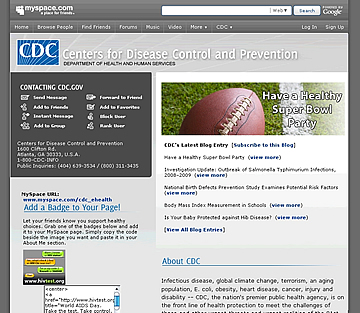
Stay informed about the ongoing peanut butter and peanut-containing product recall through CDC's social network profiles:
- CDC on MySpace (CDC)
- CDC on DailyStrength (CDC)
Badges for Social Networks
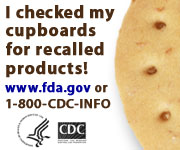 Add a badge to your social network profile. Let your friends know that you support healthy choices and encourage them to do the same by placing one of these badges on your social network profile page.
Add a badge to your social network profile. Let your friends know that you support healthy choices and encourage them to do the same by placing one of these badges on your social network profile page.
Follow updates from FDA and CDC on Twitter:
- FDA's
Recall Twitter feed (FDA)
Information and updates on FDA food and drug related recalls including the peanut butter and peanut-containing product recalls - CDC's
new Twitter feed for Emergency Information
(CDC)
Emergency announcements from CDC and partner agencies - CDC's
Twitter feed for Health Professionals (CDC)
For interested Health Professionals interested in staying up-to-date with CDC's interactive media activities (includes alerts of when new mobile content and widgets are released by CDC)
Virtual Worlds
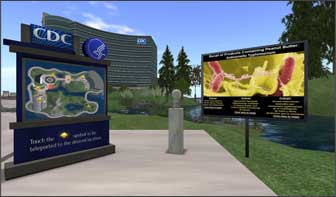 Access recall and outbreak investigation information from the virtual world Second Life. In addition to the virtual lab, awareness bracelets and biohazard suits, visitors to the CDC Second Life island can now find the following in-world information related to the peanut butter and peanut-containing product recall: streaming podcasts for adults and children, an in-world notice about the outbreak, and links to CDC information and the FDA database of product recalls.
Access recall and outbreak investigation information from the virtual world Second Life. In addition to the virtual lab, awareness bracelets and biohazard suits, visitors to the CDC Second Life island can now find the following in-world information related to the peanut butter and peanut-containing product recall: streaming podcasts for adults and children, an in-world notice about the outbreak, and links to CDC information and the FDA database of product recalls.
Web Sites
Find updated information about the peanut butter and peanut-containing product recalls from FDA.gov and CDC.gov:
Widgets
FDA Product Recall List
Add a widget to your homepage and get updated recall information and resources. The following widgets have been created to disseminate information related to the peanut butter and peanut-containing product recalls. Once you've added a widget to your homepage, blog, or Web site, the content will automatically update with current information.
-
Search for peanut butter product recalls
(CDC)
Enables searching by brand name, product description, and more. - Current U.S map of reported Salmonella Typhimurium cases (CDC)
-
Everyday Health tips for consumers
(CDC)
Includes information on the peanut butter and peanut-containing product recall. - More about CDC widgets (CDC)
Resources for Partners
Content Syndication
Syndicate information about the Salmonella outbreak to your Web pages. Content Syndication is a technical application that allows CDC partners to mirror CDC's Web content within their own sites. Web content from a CDC.gov page is exported to a partner Web site to display within the partner's Web pages. Because this is a technical application, the content is automatically updated, meaning that every time a change is made to the CDC.gov Salmonella Typhimurium outbreak Web page that change is automatically made on the partner's Web page. Content syndication provides a streamlined process for disseminating current and credible content in real-time on other Web sites. (CDC)
Below is an example:
A
CDC.gov page with Salmonella Typhimurium
outbreak information:
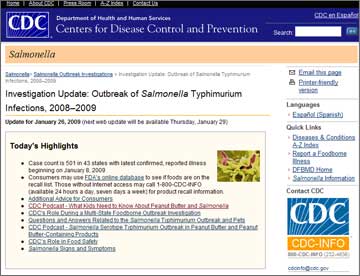
A partner page that uses syndication to display automatically updated CDC content:
For more information about Content Syndication, please email: imtech@cdc.gov.
Phone/Email: CDC National Contact Center
Have questions about the peanut butter and peanut-containing product recalls? Representatives are available 24/7 to answer your questions in English and Spanish. For up-to-date information about the recalls and hundreds of other health and safety topics:
- Call 1-800-CDC-INFO (1-800-232-4636), TTY: (888) 232-6348, English/Spanish, 24 Hours/Every Day
- Email: cdcinfo@cdc.gov
- Postal Mail:
Centers for Disease Control and Prevention
1600 Clifton Rd, Atlanta
GA 30333, U.S.A.
Web Site Graphics
Display a graphic on your Web site to encourage healthy and safe behaviors. By adding one of these images to your Web sites, you will be part of the national effort to keep consumers informed about recall activities.
Text Messages
Send a text message to your mobile subscribers. If you have a list of subscribers for text message updates, here is a message that HHS, FDA and CDC created for dissemination through local text messaging networks. (CDC)
US GOV/HHS Health Alert: Get peanut butter recall info at FDA: http://www.fda.gov/salmonella or CDC: 800-232-4636. More:http://m.cdc.gov
XML Product Recall Database
Access an XML database with the FDA's list of recalled products. FDA now provides Peanut Butter and Peanut-Containing Product Recalls data from their database in several formats (Excel, PDF and XML) as part of their commitment to be transparent, open and collaborative. This XML format will allow other institutions and citizens to incorporate this data into their own products and mashups.
Note About the Information on this Web Page: This activity was facilitated by the HHS Center for Social Media, a collaborative body dedicated to advancing social media adoption, research and evaluation among Federal agencies.
Get email updates
To receive email updates about this page, enter your email address:
Contact Us:
- Centers for Disease Control and Prevention
1600 Clifton Rd
Atlanta, GA 30333 - 800-CDC-INFO
(800-232-4636)
TTY: (888) 232-6348
English/Spanish
24 Hours/Every Day - cdcinfo@cdc.gov
